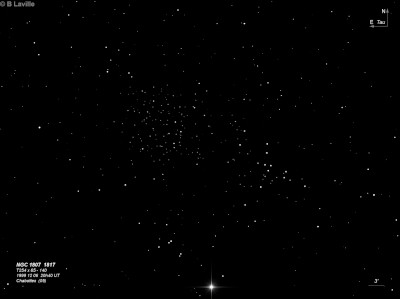
William Herschel discovered NGC 1817 = H VII-4 = h349 on 19 Feb 1784 (sweep 147) and recorded "a cluster of stars, ccattered and of very different magnitudes. They take up a space of about 20' and the cluster is coarsely circular. The weather is very indifferent so that the small stars are not very well to be seen; but I suppose there cannot be less than 150 that I might count at present." On 15 Oct 1784 (sweep 292), he reported "a cl of stars about 20 or 25' diameter, pretty rich, the stars not very small, nor very compressed." On 25 Jan 1832 (sweep 395), John Herschel wrote, "L, rich cl; stars 12...15 m; fills the field. Place that of a double star. The most compressed part is 42.5 sec foll the double star and 3' south of it." The double star is h3269 = 8.6/10.6 at 20".
200/250mm - 8" about 65 stars in 15'-20' diameter, large, fairly rich, many faint stars. Includes three brighter stars on the west side including a mag 8.5 star. Forms a poor version of the "Double cluster" with NGC 1807 25' SW.
400/500mm - 17.5" (2/11/96): large, roundish group of ~100 stars in a 15' diameter. The three brightest mag 8/9 stars lie on the west side. This trio is part of a 7' arc of 15 stars elongated N-S sharply defining the preceding side of the group. The cluster is fairly well detached except at the east side which merges into the general field density. About 5' NW of the trio described above is an unequal double h3269 = 8.6/10.6 at 20", though it appears detached from the main group. 25' SW is the bright, striking group NGC 1807 which has a cruciform outline.
Notes by Steve Gottlieb